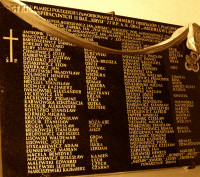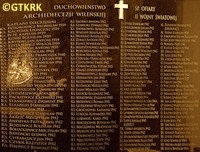Roman Catholic
St Sigismund parish
05-507 Słomczyn
85 Wiślana Str.
Konstancin deanery
Warsaw archdiocese, Poland
full list:
displayClick to display full list

searchClick to search full list by categories
wyświetlKliknij by wyświetlić pełną listę po polsku

szukajKliknij by przeszukać listę wg kategorii po polsku

Martyrology of the clergy — Poland
XX century (1914 – 1989)
personal data

surname
TAPPER
forename(s)
Nicholas (pl. Mikołaj)
function
diocesan priest
creed
Latin (Roman Catholic) Church RCmore on
en.wikipedia.org
[access: 2014.09.21]
diocese / province
Vilnius archdiocesemore on
en.wikipedia.org
[access: 2013.05.19]
RC Military Ordinariate of Polandmore on
en.wikipedia.org
[access: 2014.12.20]
academic distinctions
Theology MA
date and place
of death
17.08.1945

Vilniustoday: Vilnius city dist., Vilnius Cou., Lithuania
more on
en.wikipedia.org
[access: 2022.01.06]
alt. dates and places
of death
15.08.1945
details of death
After German and Russian invasion of Poland in 09.1939 and start of the World War II, Vilnius, where ministered, was occupied by the Russians on 19.09.1939, but already on 27.10.1939 — in accordance with the provisions of the Ribbentrop–Molotov Pact — handed over to the Lithuanians. The Lithuanian occupation lasted until 15.06.1940, when the Russians entered Vilnius again. Finally, after the German attack on 22.06.1941 their erstwhile ally, the Russians, the German occupation began on 24.06.1941.
Collaborated as a chaplain with Polish resistance Home Army AK (part of Polish Clandestine State), nom‐de‐guerre „Frog”. Ministered, among other roles, as chaplain of the 3rd Company, 5th Battalion, 77th Infantry Regiment of AK. During the „Storm” Operation — an anti‐German operation to seize control of Polish territory just before the attacking Russian troops entered — his unit was part of the Northern Group of the Vilnius–Navahrudak District of AK.
Arrested by the Russians after start of the second Russian occupation on 25.12.1944, in a group of 44 Poles accused of participation in AK attack on 19‐20.10.1944 on Ejszyszki prison where hundreds of Poles were held by the genocidal Russian NKVD organisation.
Tortured in Ejszyszki prison.
Next moved to Troki and then Vilnius (prob. Lukiškės) prisons.
On 05.04.1945 sentenced by the genocidal NKVD/MGB, together with 10 co–prisoners — pursuant to Art. 58‐2 of the Russian penal code — to death.
Murdered prob. in Vilnius, in NKVD/MGB HQs at Łukiski Square, and buried in a mass grave in Tuskulanum palace (in Żyrmunt part of Vilnius).
cause of death
mass murder
perpetrators
Russians
sites and events
Vilnius (Tuskulanum)Click to display the description, Vilnius (Łuskis Square)Click to display the description, Vilnius (Lukiškės)Click to display the description, Ribbentrop‐MolotovClick to display the description, Pius XI's encyclicalsClick to display the description
date and place
of birth
06.10.1913

Warsawtoday: Warsaw city pov., Masovia voiv., Poland
more on
en.wikipedia.org
[access: 2021.10.09]
parents
TAPPER Peter
🞲 ?, ? — 🕆 ?, ?

ILASICKA Janet
🞲 ?, ? — 🕆 ?, ?
presbyter (holy orders)
ordination
11.06.1938

Vilniustoday: Vilnius city dist., Vilnius Cou., Lithuania
more on
en.wikipedia.org
[access: 2022.01.06]
St Stanislav the Bishop and Martyr and St Vladislav RC cathedral churchmore on
en.wikipedia.org
[access: 2025.03.14]
positions held
1941 – 1944
vicar — Eišiškėstoday: Eišiškės eld., Šalčininkai dist., Vilnius Cou., Lithuania
more on
en.wikipedia.org
[access: 2020.12.11] ⋄ Ascension of the Lord RC parish ⋄ Raduntoday: Radun ssov., Voranava dist., Grodno reg., Belarus
more on
en.wikipedia.org
[access: 2022.01.06] RC deanery
1940 – 1941
vicar — Maišiagalatoday: Maišiagala eld., Vilnius dist., Vilnius Cou., Lithuania
more on
en.wikipedia.org
[access: 2021.12.18] ⋄ Assumption of the Blessed Virgin Mary RC parish ⋄ Verkiai Calvarytoday: part of Vilnius, Vilnius city dist., Vilnius Cou., Lithuania
more on
en.wikipedia.org
[access: 2020.11.27] RC deanery
1939 – 1940
prefect — Vilniustoday: Vilnius city dist., Vilnius Cou., Lithuania
more on
en.wikipedia.org
[access: 2022.01.06] ⋄ schools No. 11 and No. 19
1938 – 1939
prefect — Prazarokitoday: Prazaroki ssov., Hlybokaye dist., Vitebsk reg., Belarus
more on
en.wikipedia.org
[access: 2022.01.06] ⋄ primary schools ⋄ Assumption of the Blessed Virgin Mary RC parish ⋄ Hlybokayetoday: Hlybokaye dist., Vitebsk reg., Belarus
more on
en.wikipedia.org
[access: 2021.10.09] RC deanery
1938
administrator — Dūkštastoday: Dūkštos eld., Ignalina dist., Utena Cou., Lithuania
more on
en.wikipedia.org
[access: 2022.01.06] ⋄ St Stanislav Kostka the Confessor RC parish ⋄ Braslawtoday: Braslaw dist., Vitebsk reg., Belarus
more on
en.wikipedia.org
[access: 2021.09.29] RC deanery
1932 – 1938
student — Vilniustoday: Vilnius city dist., Vilnius Cou., Lithuania
more on
en.wikipedia.org
[access: 2022.01.06] ⋄ Department of Theology, Stephen Batory University [i.e. Vilnius University (from 1945) / some faculties acting clandestinely (1939‐1945) / closed by Lithuanians (1939) / Stephen Batory University (1919‐1939)]
1932 – 1938
student — Vilniustoday: Vilnius city dist., Vilnius Cou., Lithuania
more on
en.wikipedia.org
[access: 2022.01.06] ⋄ philosophy and theology, Theological Seminary
others related
in death
BORUSEWICZClick to display biography Vincent, GUSTAITISClick to display biography Francis, BALČIŪNASClick to display biography Vladislav, BEINORAVIČIUSClick to display biography Boleslav, STASEVIČIUSClick to display biography Adolph
sites and events
descriptions
Vilnius (Tuskulanum): A palace with a surrounding garden in Żyrmunty quarters in Vilnius where in 1940s Russians secretely buried in mass graves bodies of murdered Polish soldiers of resistance Home Army AK (part of Polish Clandestine State), Lithuanian partisans and German collaborators, captured by the genocidal Russian NKVD/MGB organization. In 1990. c. 706 bodies were discovered in the palace. (more on: en.wikipedia.orgClick to attempt to display webpage
[access: 2017.06.16])
Vilnius (Łuskis Square): In the former Tsarist prison and 1918‐1939 Polish Republic voivodeship buildings at Łukiski Square (Ofiarna Str.) Germans in 1941 set up the Gestapo HQ and jail and Russians in 1944 the Vilnius HQ of the genocidal NKVD/MGB organisation. Thousands of Polish soldiers of resistance Home Army AK (part of Polish Clandestine State), Lithuanian partisans and during Russian occupation after 1944 — German collaborators were interrogated and tortured there. In the basements death sentences were carried out. In 1944‐1960 alone Russians carried out more then 1,000 death sentences there — some of the bodies were secretely buried in a nearby Tuskulanum palace in Vilnius. (more on: en.wikipedia.orgClick to attempt to display webpage
[access: 2017.06.16])
Vilnius (Lukiškės): Vilnius prison used both by Russians and Germans. Thousands of Poles were kept there. From 2,000 to 16,000 prisoners were jailed at any time there. In 06.1941, after German invasion, Russians murdered most of the prisoners. (more on: en.wikipedia.orgClick to attempt to display webpage
[access: 2021.07.04])
Ribbentrop‐Molotov: Genocidal Russian‐German alliance pact between Russian leader Joseph Stalin and German leader Adolf Hitler signed on 23.08.1939 in Moscow by respective foreign ministers, Mr. Vyacheslav Molotov for Russia and Joachim von Ribbentrop for Germany. The pact sanctioned and was the direct cause of joint Russian and German invasion of Poland and the outbreak of the World War II in 09.1939. In a political sense, the pact was an attempt to restore the status quo ante before 1914, with one exception, namely the „commercial” exchange of the so‐called „Kingdom of Poland”, which in 1914 was part of the Russian Empire, fore Eastern Galicia (today's western Ukraine), in 1914 belonging to the Austro‐Hungarian Empire. Galicia, including Lviv, was to be taken over by the Russians, the „Kingdom of Poland” — under the name of the General Governorate — Germany. The resultant „war was one of the greatest calamities and dramas of humanity in history, for two atheistic and anti‐Christian ideologies — national and international socialism — rejected God and His fifth Decalogue commandment: Thou shall not kill!” (Abp Stanislav Gądecki, 01.09.2019). The decisions taken — backed up by the betrayal of the formal allies of Poland, France and Germany, which on 12.09.1939, at a joint conference in Abbeville, decided not to provide aid to attacked Poland and not to take military action against Germany (a clear breach of treaty obligations with Poland) — were on 28.09.1939 slightly altered and made more precise when a treaty on „German‐Russian boundaries and friendship” was agreed by the same murderous signatories. One of its findings was establishment of spheres of influence in Central and Eastern Europe and in consequence IV partition of Poland. In one of its secret annexes agreed, that: „the Signatories will not tolerate on its respective territories any Polish propaganda that affects the territory of the other Side. On their respective territories they will suppress all such propaganda and inform each other of the measures taken to accomplish it”. The agreements resulted in a series of meeting between two genocidal organization representing both sides — German Gestapo and Russian NKVD when coordination of efforts to exterminate Polish intelligentsia and Polish leading classes (in Germany called «Intelligenzaktion», in Russia took the form of Katyń massacres) where discussed. Resulted in deaths of hundreds of thousands of Polish intelligentsia, including thousands of priests presented here, and tens of millions of ordinary people,. The results of this Russian‐German pact lasted till 1989 and are still in evidence even today. (more on: en.wikipedia.orgClick to attempt to display webpage
[access: 2015.09.30])
Pius XI's encyclicals: Facing the creation of two totalitarian systems in Europe, which seemed to compete with each other, though there were more similarities than contradictions between them, Pope Pius XI issued in 03.1937 (within 5 days) two encyclicals. In the „Mit brennender Sorge” (Eng. „With Burning Concern”) published on 14.03.1938, condemned the national socialism prevailing in Germany. The Pope wrote: „Whoever, following the old Germanic‐pre‐Christian beliefs, puts various impersonal fate in the place of a personal God, denies the wisdom of God and Providence […], whoever exalts earthly values: race or nation, or state, or state system, representatives of state power or other fundamental values of human society, […] and makes them the highest standard of all values, including religious ones, and idolizes them, this one […] is far from true faith in God and from a worldview corresponding to such faith”. On 19.03.1937, published „Divini Redemptoris” (Eng. „Divine Redeemer”), in which criticized Russian communism, dialectical materialism and the class struggle theory. The Pope wrote: „Communism deprives man of freedom, and therefore the spiritual basis of all life norms. It deprives the human person of all his dignity and any moral support with which he could resist the onslaught of blind passions […] This is the new gospel that Bolshevik and godless communism preaches as a message of salvation and redemption of humanity”… Pius XI demanded that the established human law be subjected to the natural law of God , recommended the implementation of the ideal of a Christian state and society, and called on Catholics to resist. Two years later, National Socialist Germany and Communist Russia came together and started World War II. (more on: www.vatican.vaClick to attempt to display webpage
[access: 2023.05.28], www.vatican.vaClick to attempt to display webpage
[access: 2023.05.28])
sources
personal:
biographies.library.nd.eduClick to attempt to display webpage
[access: 2014.11.14], podziemiezbrojne.blox.plClick to attempt to display webpage
[access: 2014.11.14], wpolityce.plClick to attempt to display webpage
[access: 2019.10.13], ru.openlist.wikiClick to attempt to display webpage
[access: 2019.10.13]
bibliographical:
„Vilnius archdiocese clergy martyrology 1939‐1945”, Fr Thaddeus Krahel, Białystok, 2017
„Lexicon of Polish clergy repressed in USSR in 1939‐1988”, Roman Dzwonkowski, SAC, ed. Science Society KUL, 2003, Lublin
original images:
www.radzima.netClick to attempt to display webpage
[access: 2014.11.14], ipn.gov.plClick to attempt to display webpage
[access: 2019.02.02], www.ciekawepodlasie.plClick to attempt to display webpage
[access: 2020.07.31]
LETTER to CUSTODIAN/ADMINISTRATOR
If you have an Email client on your communicator/computer — such as Mozilla Thunderbird, Windows Mail or Microsoft Outlook, described at WikipediaPatrz:
en.wikipedia.org, among others — try the link below, please:
LETTER to CUSTODIAN/ADMINISTRATORClick and try to call your own Email client
If however you do not run such a client or the above link is not active please send an email to the Custodian/Administrator using your account — in your customary email/correspondence engine — at the following address:

giving the following as the subject:
MARTYROLOGY: TAPPER Nicholas
To return to the biography press below:
 Click to return to biography
Click to return to biography










